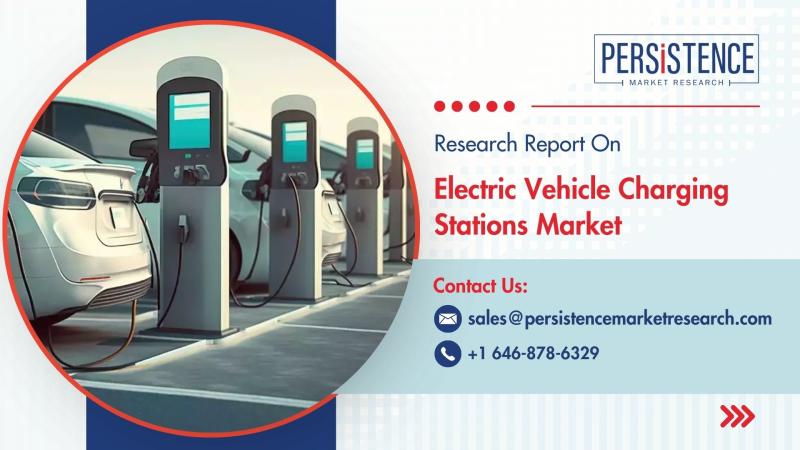Introduction:
The electric vehicle (EV) revolution is accelerating globally, driven by technological advancements, environmental concerns, and supportive government policies. A crucial component of this transformation is the expansion of EV charging infrastructure. As more consumers and businesses embrace electrified mobility, the market for charging stations is experiencing significant growth. This surge reflects both increased EV adoption and the necessity for convenient, efficient, and accessible charging solutions.
Get a Sample PDF Brochure of the Report (Use Corporate Email ID for a Quick Response): www.persistencemarketresearch.com/samples/13237
Market Growth and Key Drivers:
The rapid growth of EV sales has directly influenced the demand for charging stations. Automakers are expanding their EV portfolios, making these vehicles more accessible to the general public. Governments worldwide are implementing incentives, tax benefits, and mandates to promote cleaner transportation. These initiatives include funding for charging infrastructure and stringent emission regulations, encouraging both public and private entities to invest in charging networks.
Another key driver is technological innovation. Advancements in battery technology, ultra-fast charging, and smart grid integration are revolutionizing the industry. High-power direct current (DC) fast chargers can now replenish an EV’s battery within minutes, significantly reducing wait times and improving user experience. Additionally, the integration of renewable energy sources, such as solar and wind, into charging networks enhances sustainability while lowering operational costs.
Types of Charging Stations:
EV charging stations are broadly categorized into three levels based on charging speed and power output:
Level 1 Charging: The most basic form, typically using a standard household outlet. While cost-effective, it is best suited for overnight charging due to its slow rate.
Level 2 Charging: Provides a faster alternative for residential, workplace, and public charging. It operates at a higher voltage, significantly reducing charge times.
DC Fast Charging: The fastest option, designed for commercial and highway corridor locations. These stations cater to long-distance travelers and fleet operators who require rapid turnaround times.
The growth of ultra-fast charging networks, including those capable of delivering over 350 kW, is enhancing the viability of EVs for all users, addressing range anxiety and promoting wider adoption.
Infrastructure Expansion and Investment Trends:
Investment in charging infrastructure is surging, with both governments and private enterprises actively participating. Large-scale deployment of charging networks is being supported by strategic collaborations among automakers, energy providers, and technology firms. Companies specializing in EV charging solutions are expanding their footprint, establishing stations in urban centers, highways, and rural areas to ensure comprehensive coverage.
The adoption of smart charging solutions is also reshaping the market. Features such as mobile apps for locating and reserving chargers, dynamic pricing based on demand, and vehicle-to-grid (V2G) capabilities are becoming more common. These advancements contribute to an efficient, user-friendly charging ecosystem.
Challenges and Opportunities:
Despite the positive momentum, the market faces challenges. High installation costs for fast chargers, grid capacity constraints, and the need for standardized charging protocols remain significant hurdles. Additionally, ensuring equitable access to charging stations in underserved areas is crucial for widespread adoption.
However, these challenges present opportunities for innovation and strategic planning. Companies are exploring battery-buffered charging stations to reduce grid strain, while governments are implementing policies to encourage investment in underserved regions. Emerging technologies such as wireless charging and ultra-fast battery swapping systems are also gaining traction, offering potential solutions to current limitations.
Regional Market Trends:
The expansion of EV charging infrastructure varies across regions, influenced by government policies, consumer adoption rates, and economic factors.
North America: Strong government support, incentives, and corporate investments are driving rapid growth. The U.S. aims to build a vast charging network, particularly along major highways, to support nationwide EV adoption.
Europe: Stringent emission regulations and ambitious sustainability goals are fueling market expansion. Countries like Germany, the U.K., and Norway have extensive charging networks, supported by public and private funding.
Asia-Pacific: Led by China, this region dominates the global EV market. Government initiatives, coupled with a growing EV user base, are resulting in significant investments in charging infrastructure. Japan and South Korea are also making strides in expanding their networks.
Future Outlook:
The future of the EV charging station market looks promising, with continued growth expected over the next decade. Governments will play a pivotal role by implementing supportive policies, while private sector innovation will drive efficiency and accessibility. As charging technology continues to evolve, the focus will be on creating a seamless and convenient experience for users.
Sustainability will remain at the core of infrastructure development. The integration of renewable energy, energy storage solutions, and smart grid technology will enhance efficiency and reduce the environmental footprint of charging networks. Additionally, advancements in vehicle-to-grid capabilities will transform EVs into active participants in energy ecosystems.
Conclusion:
The surge in the EV charging station market underscores the broader transition toward sustainable transportation. With strong investment, technological advancements, and supportive policies, the expansion of charging networks is ensuring that EV adoption continues to rise. As infrastructure improves and innovations emerge, the vision of a cleaner, electrified future is becoming a reality, benefiting consumers, businesses, and the environment alike.
Explore the Latest Trending “Exclusive Article” @
• https://www.linkedin.com/pulse/electric-cargo-bike-market-grows-amid-rising-eco-friendly-uph4f/
• https://prnewssync.medium.com/global-electric-cargo-bike-market-surges-with-urban-logistics-boom-68f90930695f
• https://theautonewz.wordpress.com/2025/03/06/electric-cargo-bikes-gain-popularity-for-sustainable-deliveries/
• https://apsnewsmedia.blogspot.com/2025/03/demand-for-electric-cargo-bikes-rises.html
• https://www.manchesterprofessionals.co.uk/article/marketing-pr/84406/electric-cargo-bike-market-expands-with-green-transport-solutions
Contact Us:
Persistence Market Research
G04 Golden Mile House, Clayponds Lane
Brentford, London, TW8 0GU UK
USA Phone: +1 646-878-6329
UK Phone: +44 203-837-5656
Email: sales@persistencemarketresearch.com
Web: https://www.persistencemarketresearch.com
About Persistence Market Research:
At Persistence Market Research, we specialize in creating research studies that serve as strategic tools for driving business growth. Established as a proprietary firm in 2012, we have evolved into a registered company in England and Wales in 2023 under the name Persistence Research & Consultancy Services Ltd. With a solid foundation, we have completed over 3600 custom and syndicate market research projects, and delivered more than 2700 projects for other leading market research companies’ clients.
Our approach combines traditional market research methods with modern tools to offer comprehensive research solutions. With a decade of experience, we pride ourselves on deriving actionable insights from data to help businesses stay ahead of the competition. Our client base spans multinational corporations, leading consulting firms, investment funds, and government departments. A significant portion of our sales comes from repeat clients, a testament to the value and trust we’ve built over the years.
This release was published on openPR.


